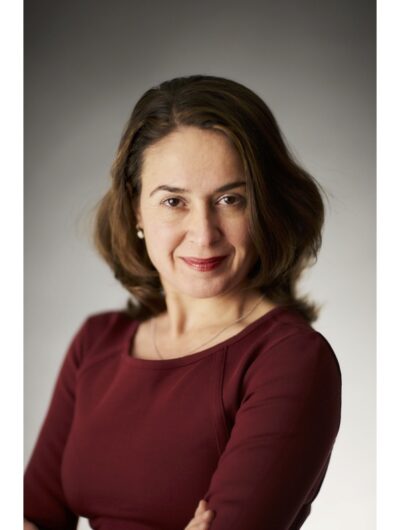A Conversation with…Dr. Meghan Lane-Fall

Dr. Meghan Lane-Fall, MD, MHSP, FCCP
University of Pennsylvania,
Perelman School of Medicine
Philadelphia, Pennsylvania
This article brings to your attention Dr. Meghan Lane-Fall, an extraordinarily achieved female physician-scientist who continues to excel in many aspects of Anesthesiology and Critical Care. I invited Dr. Lane-Fall to be the center of this story because I am impressed and inspired by her remarkable achievements and her capacity to remain approachable.
Dr. Lane-Fall graduated magna cum laude at the University of California, Berkeley, and received an AB degree in 2001. She received an MD degree at Yale University School of Medicine in 2006. After completing the Anesthesiology residency and the Critical Care fellowship at the University of Pennsylvania in 2011, Dr. Lane-Fall dedicated more time to research education, obtaining an MS in Health Policy Research at Perelman School of Medicine, the University of Pennsylvania, in 2013. I was fortunate to have an interview with Dr. Lane-Fall and I will share with you her answers.
Monica Lupei: When during your Anesthesiology training did you decide to specialize in Critical Care Medicine?
Meghan Lane-Fall: I was one of those Medical Students who loved everything about medicine. I fell in love with Anesthesiology for all the reasons many of us do. Still, I thought I would miss the diagnostic pieces of medicine and the ability to lead a team and follow patients throughout their course. I came into residency with the idea that I would be interested in Critical Care, which seems like a right fit for me; I get to talk with lots of people, I interact with patients and families, I get to work with patients at times of their lives that are deeply critical. Critical Care is really impactful work.
Dr. Lane-Fall's vast research interests revolve around patient safety and include strategies to support safe and high-quality care of hospitalized patients, implementing effective evidence-based practice in acute care, learning from human factors, and anesthesia handoff challenges.
She is a prolific scientific writer and published more than 100 manuscripts, out of which 73 are first, senior, or sole-author publications.
Dr. Lane-Fall received numerous grants. Two important ones are “Handoffs and Transitions in Critical Care – Understanding Scalability” RO1HL National Institute of Health; and “Identifying Facilitators and Barriers of Diversity and Representativeness in RCTs,” project #1 in the more significant center grant “Behavioral Economics to Transform Trial Enrollment Representativeness (BETTER) Center,” American Heart Association.
She has numerous editorial and grant reviewer positions, including Associate Editor for Anesthesia & Analgesia and Anesthesiology journals.
ML: Is it necessary to have a research focus as a physician scientist or is a broader research interest also possible?
ML-F: I typically tell people it's instructive to think about the dichotomy of being a principal investigator versus a collaborator. If you want to be a principal investigator, you get to decide what the vision, the mission, and the direction is; you get to ask the questions, but you have all the responsibilities of a small business leader, which means you need to secure the funding, you need to staff the team, you need to lead the team and make sure everyone is doing the work, and you're responsible for sharing the output with the world, writing the manuscripts or making sure they get written, disseminating all the information. It's a tremendously rewarding enterprise, but it takes a lot of time and brings a lot of responsibility. If you are a collaborator, you don't have the same responsibility, and you can work on various fields such as cardiac research, urology, peds, and many different things. If you're broadly interested in research, being a collaborator can be a rewarding pathway to participating in research. The tradeoff is that you don't necessarily get to drive where it's going.
ML: What is the main advice you would give to an early career physician-scientist?
ML-F: The main advice for people is to do some honest self-reflection about who they are, what they want, and where they want their impact on the world, health, or critical care to be. If you know that, you might have more insight into what types of questions you would want to ask. Once you know what the questions are, you know what the team should look like and what skills you need to execute the projects. Once you have those questions and those skills, you can think of who would fund this and how you can make a compelling proposal to get this funded. It all stems from that core question of what you want to do.
Dr. Lane-Fall serves on various national and international professional and scientific committees and chairs several such committees. She also has extensive leadership experience proving she made a difference and invested in growing our Anesthesiology Critical Care specialty. Some of her current leadership positions include Director of Research and Scholarship at Penn Center for Healthcare Improvement and Patient Safety, Director of Acute Care Implementation Research at Penn Implementation Science Center at the Leonard Davis Institute of Health Economics, University of Pennsylvania, and Vice President, Anesthesia Patient Safety Foundation. Among her numerous awards and honors, Dr. Lane-Fall received the Patient Safety Advocate Award from the Hospital of the University of Pennsylvania in 2011. She was the University of Pennsylvania Health System Overall Winner for the Quality and Patient Safety Award, Handoffs and Transitions in Critical Care, in 2016.
ML: Can a physician-scientist advocate for patients?
ML-F: Yes. One example is the representation of various groups in research; as scientists, we can look for steps to improve the representation of a diverse group of patients in our research, so the science that we create reflects all the people we care for. The second example would be thinking about implementation science as a deeply engaging stakeholder enterprise; some implementation science teams bring patients and patients’ advocates into the team as co-investigators, so their perspectives are incorporated into the work that we do.
Dr. Lane-Fall earned considerable academic achievements and appointments. She is the Co-director of the Penn Center for Perioperative Outcomes Research and Transformation, Co-Medical Director of the Trauma Surgery Intensive Care Unit at Penn Presbyterian Medical Center, Founder, and Co-Medical Director of the COVID-19 Perioperative ICU, Hospital of the University of Pennsylvania, Associate Professor of Anesthesiology and Critical Care at the Perelman School of Medicine, University of Pennsylvania, and Associate Professor of Epidemiology at the Perelman School of Medicine, Vice Chair of Inclusion, Diversity, and Equity and member of Anesthesia Leadership Team, Department of Anesthesiology and Critical Care, University of Pennsylvania, to name just a few.
ML: What are the essential aspects necessary to promote inclusion, diversity, and equity at a department, institution, or professional society level?
ML-F: When we think about inclusion, diversity, and equity, we sometimes lump them altogether. In general, we want to provide equitable care, we want our patients to have superior outcomes irrespective of their background and identity, and we, as clinicians, want to be respected and want to work in a place where we are valued and part of the team. I believe deeply that inclusion within healthcare teams makes us better clinicians and better scientists. It makes the care safer because we can see things from different perspectives and see some of the vulnerabilities in the system.
In terms of how you get there, institutions, in general, need to engage in strategic planning that is focused on inclusion, diversity, and equity.
In 2014, the Association of American Medical Colleges (AAMC) published a guide to strategic planning for diversity and inclusion. It’s a great resource and freely downloadable. As part of that strategic planning, you do an environmental scan and figure out where your institution stands. Suppose you’re starting in a place where you have to convince people about the importance of diversity and inclusion. In that case, the initiatives you are going to undertake will look very different than if you are in an organization where there is work with microaggression, and anti-racism, providing language concordance services for people who have limited English proficiency. After figuring out where to start, you can have a conversation with people in your organization about what the goals are and what to prioritize in the next 3 to 5 years. It does take a systematic approach that takes resources and time. What I would encourage readers to think about is that this work should not be purely performative. It is important to give this topic a lot of time and thought.
ML: What do we need to do to increase the awareness about inclusion, diversity, and equity in our Anesthesiology Critical Care specialty?
ML-F: We are not where we ought to be concerning inclusion, diversity, and equity in our Anesthesiology Critical Care, and there are a few indicators of that. When we look at the diversity of the specialty overall, it does not reflect the diversity of the population we serve, the diversity of the medical trainees. Our fellow classes are increasingly diverse, but it's moving very slowly. We have some work to do with the trainees', the intensivists', and especially the leadership composition. We can extrapolate a bit from other disciplines that there is probably a link between our teams' diversity and the care we offer.
I am enthusiastic about structural interventions to get us closer to where we want to get. If you think about how we select fellows to interview, for instance, how much weight we put on their in-training exams and board scores. These exam scores predict future exam performance that doesn't necessarily translate into the care provided. When we select clinicians at the fellowship stage, I hope we can take a more holistic view of the candidates so we can look at the full range of folks interested in critical care and ultimately diversify our specialty. Similarly, when we think about faculty candidates, how much emphasis do we put on where they trained and their "academic pedigree" as compared to demonstrated excellence in clinical care? When we look for leaders, are we transparent about position openings? I can think about institutions where a division chief or program director position opens, and someone gets put in a position without a call for applications, without considering all the people who might be eligible. We probably shouldn't be doing that anymore. I think there are some structural interventions that we can take that would support those values of inclusion, diversity, and equity in Anesthesiology Critical Care.




































